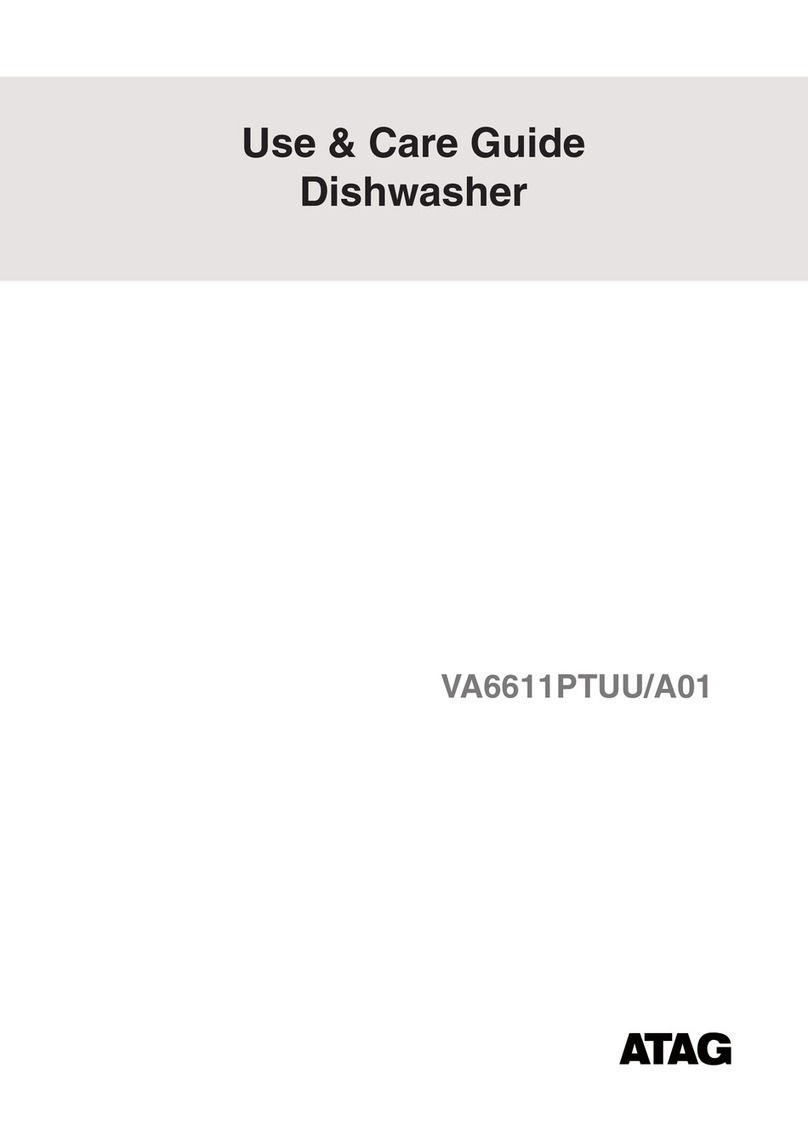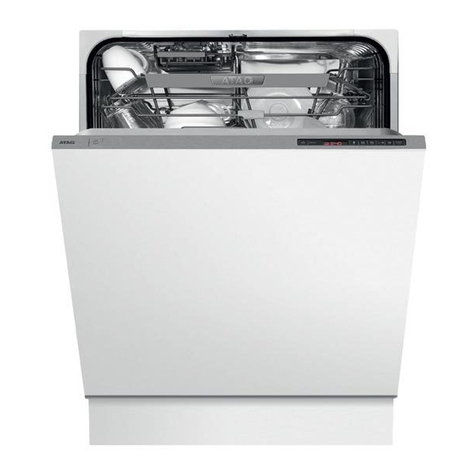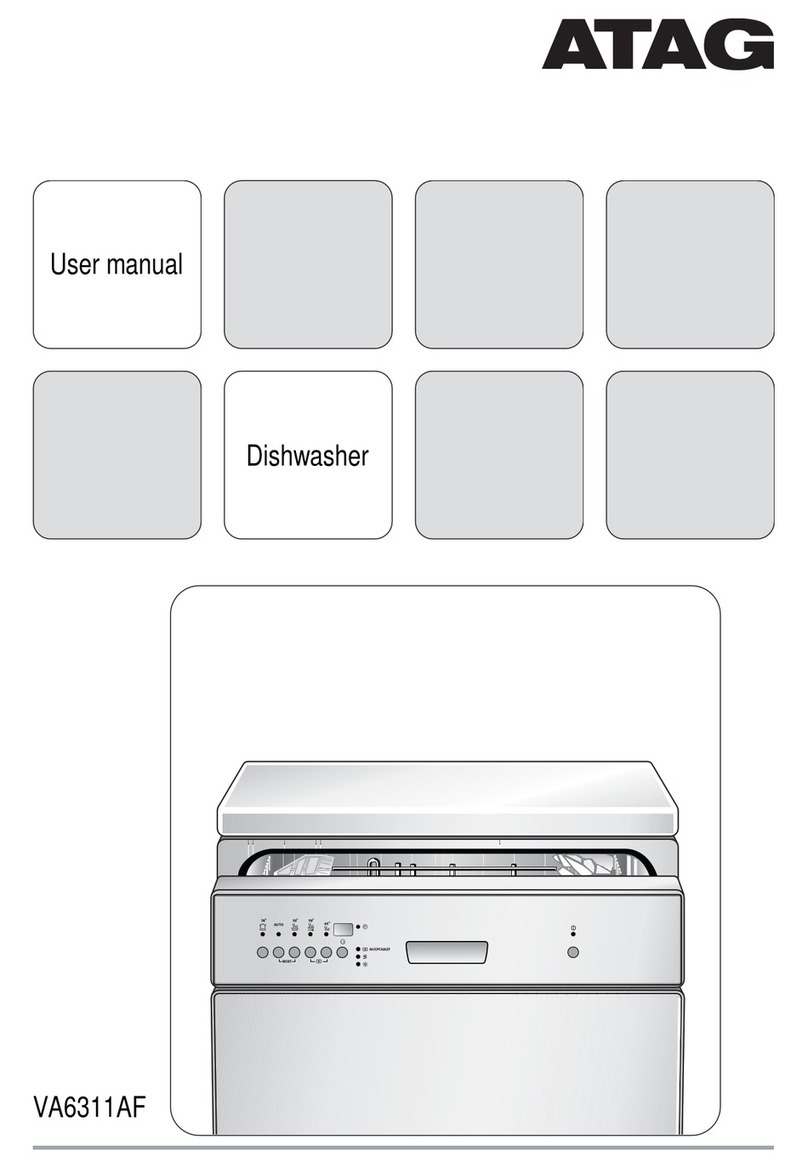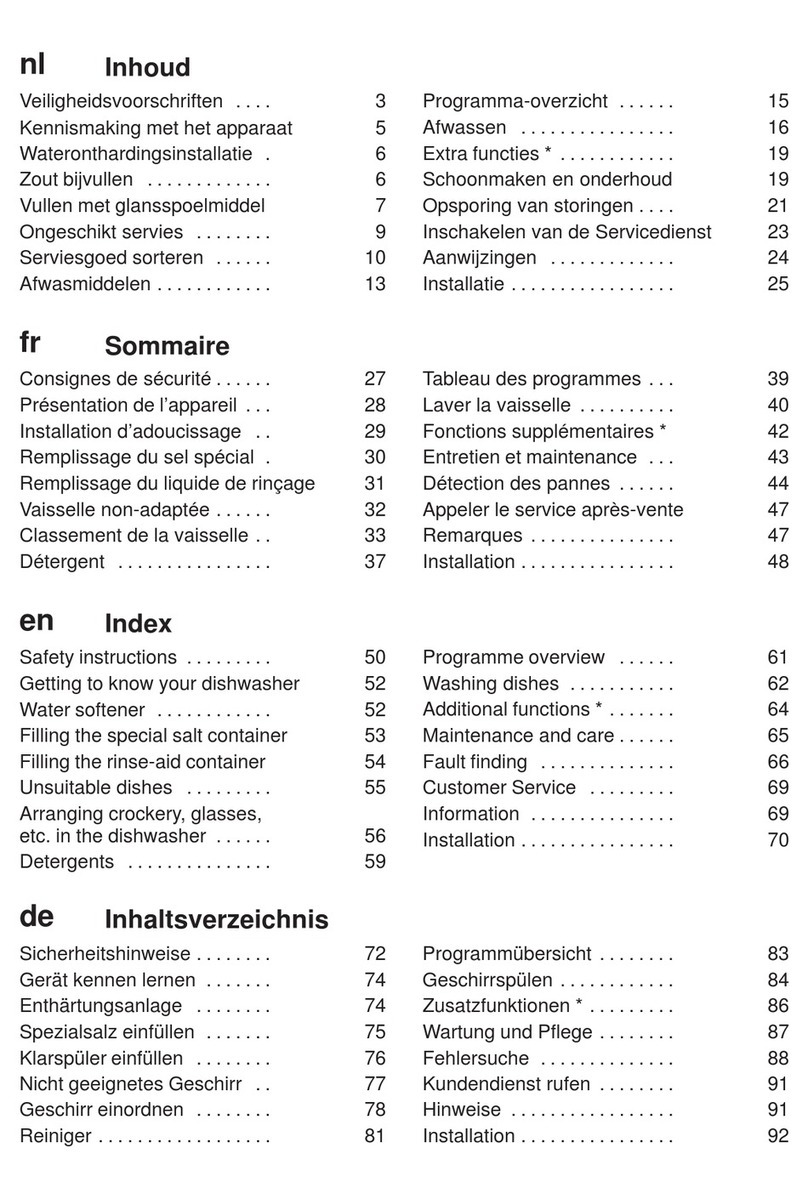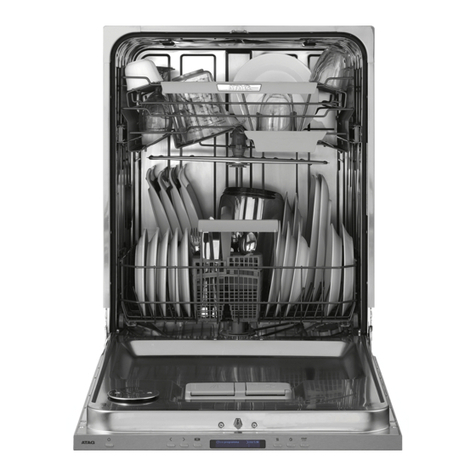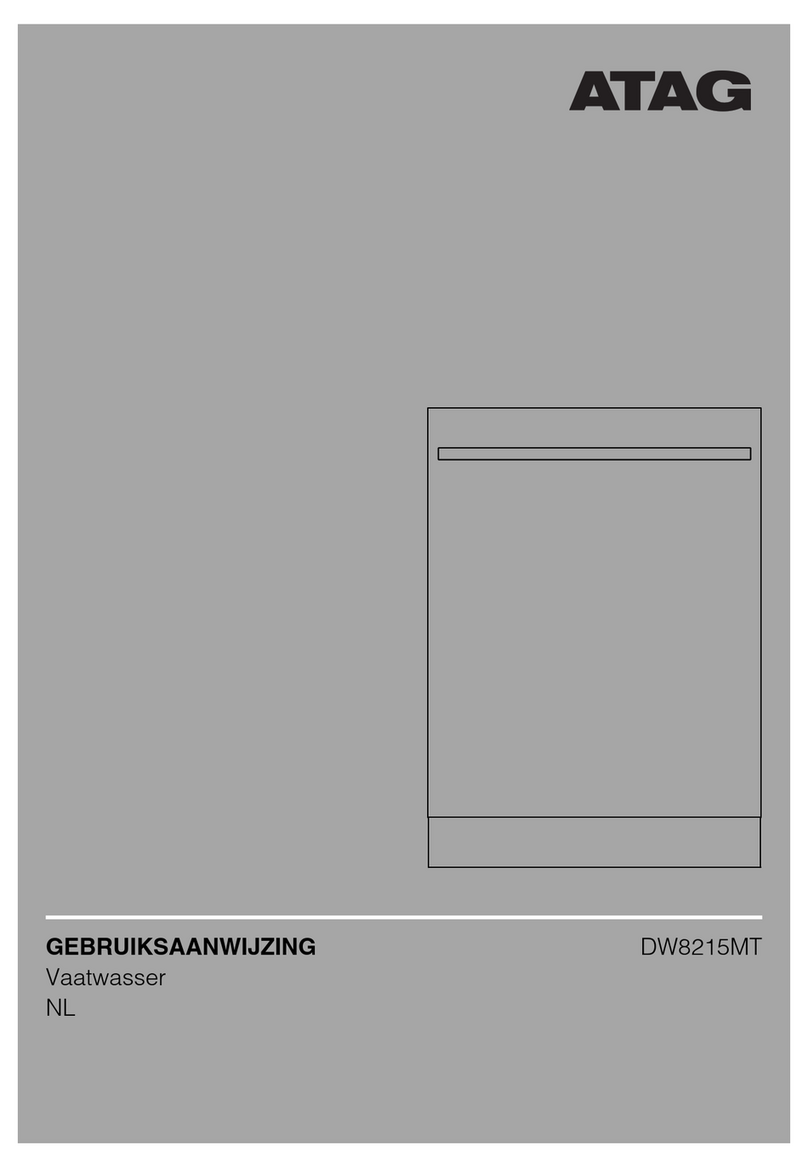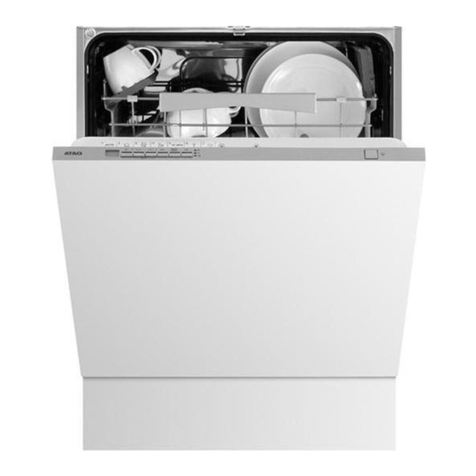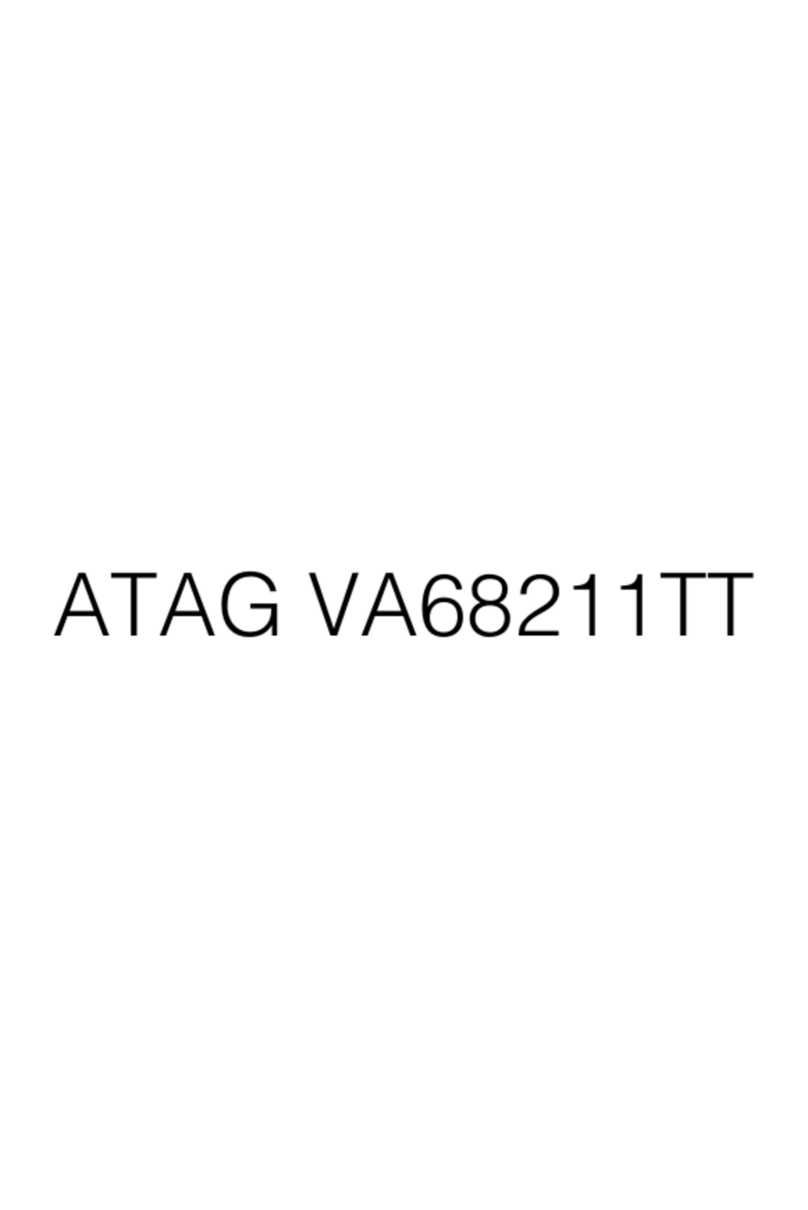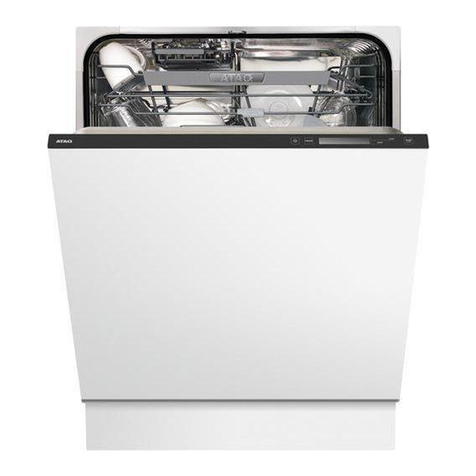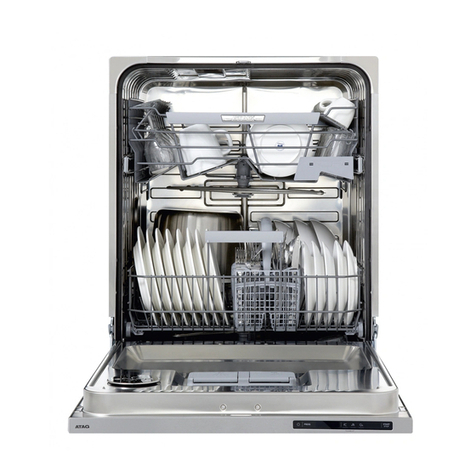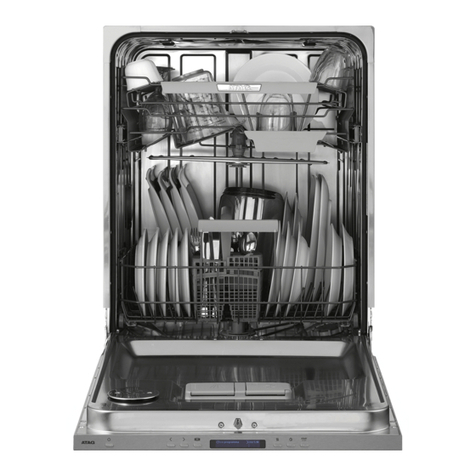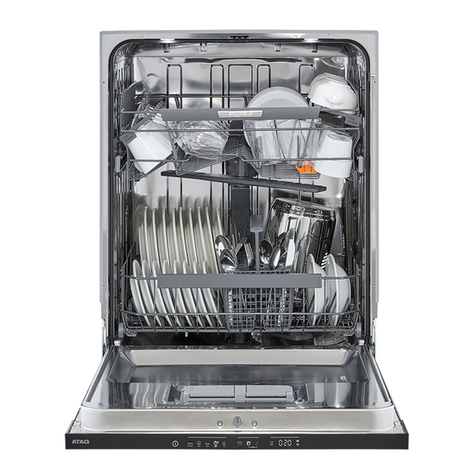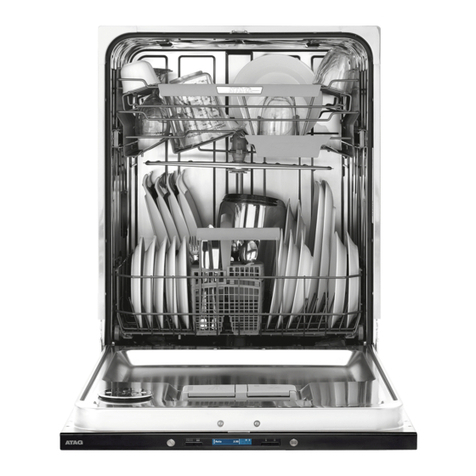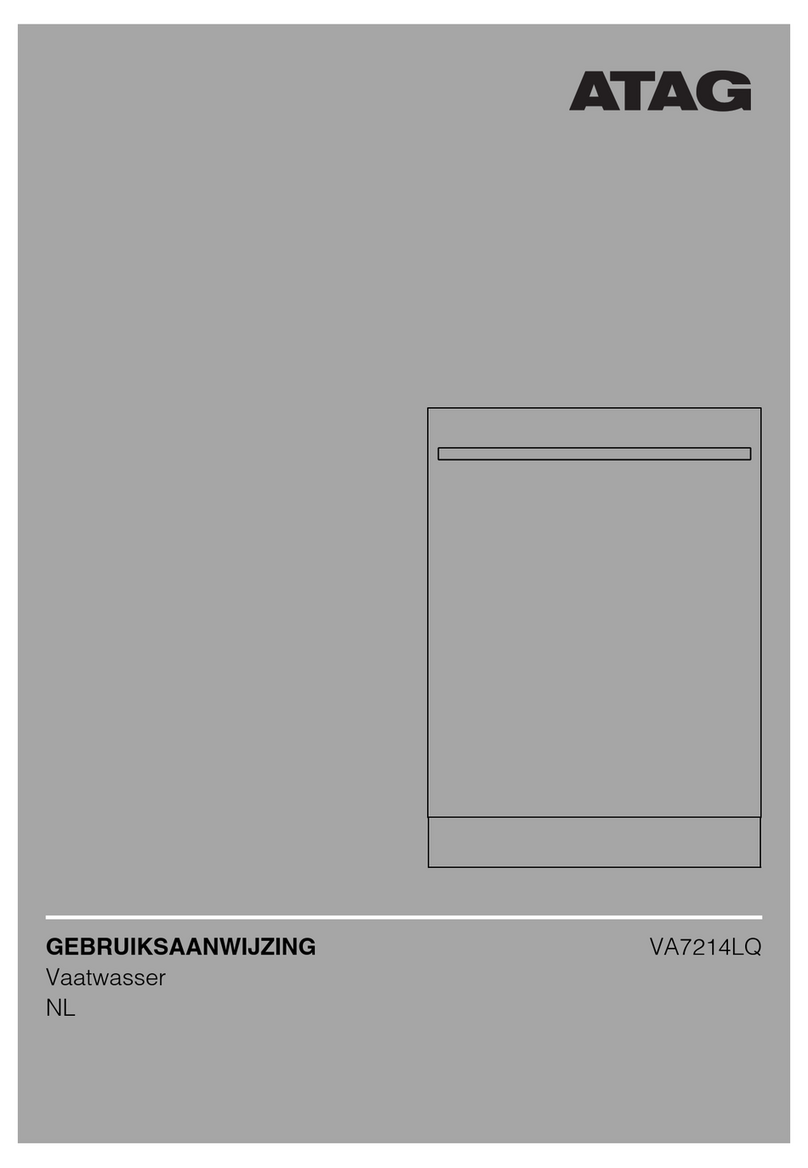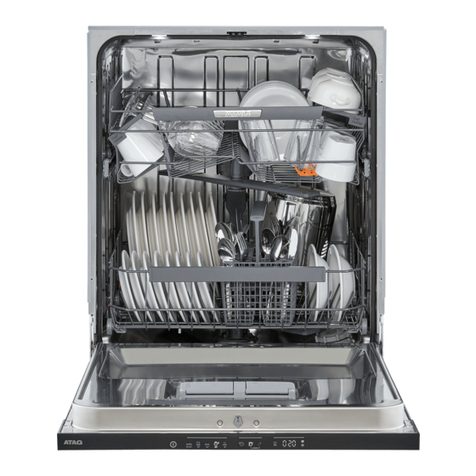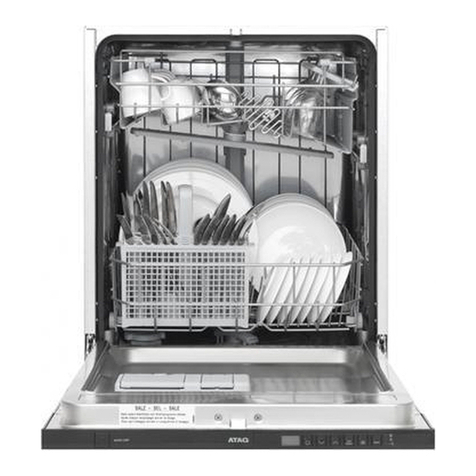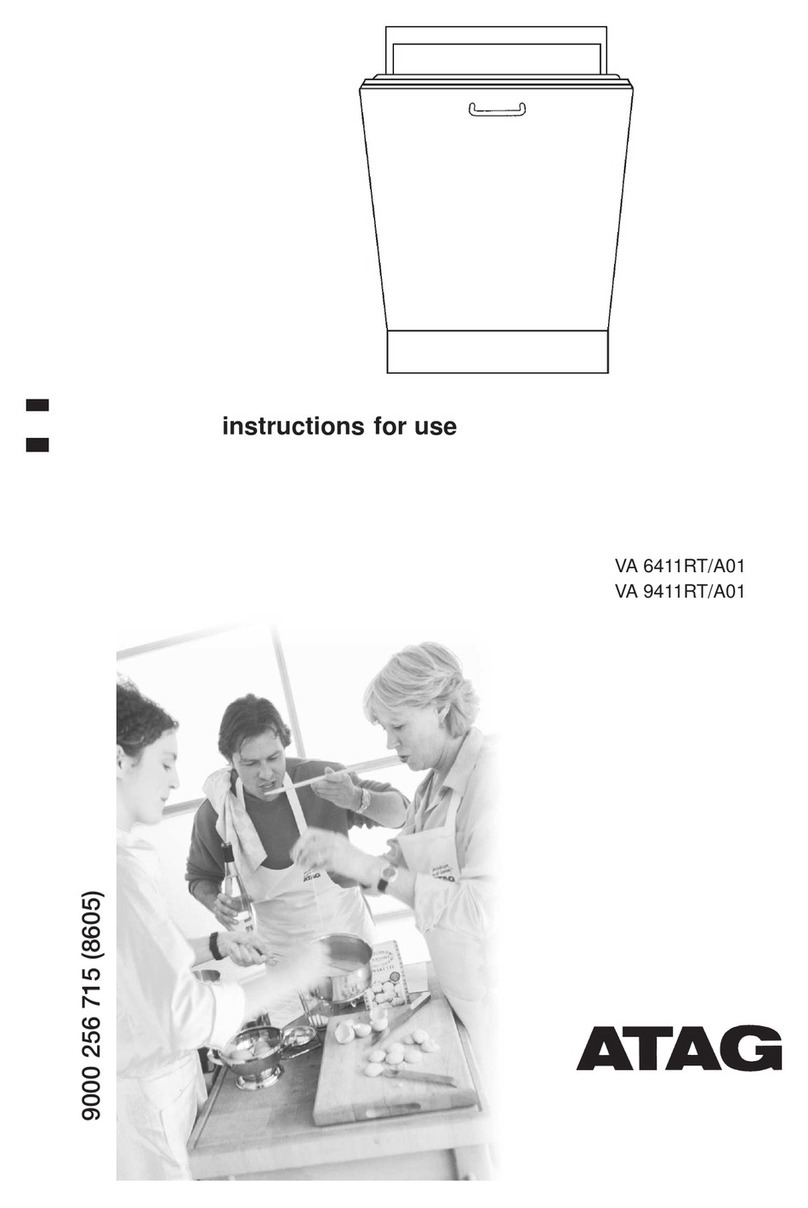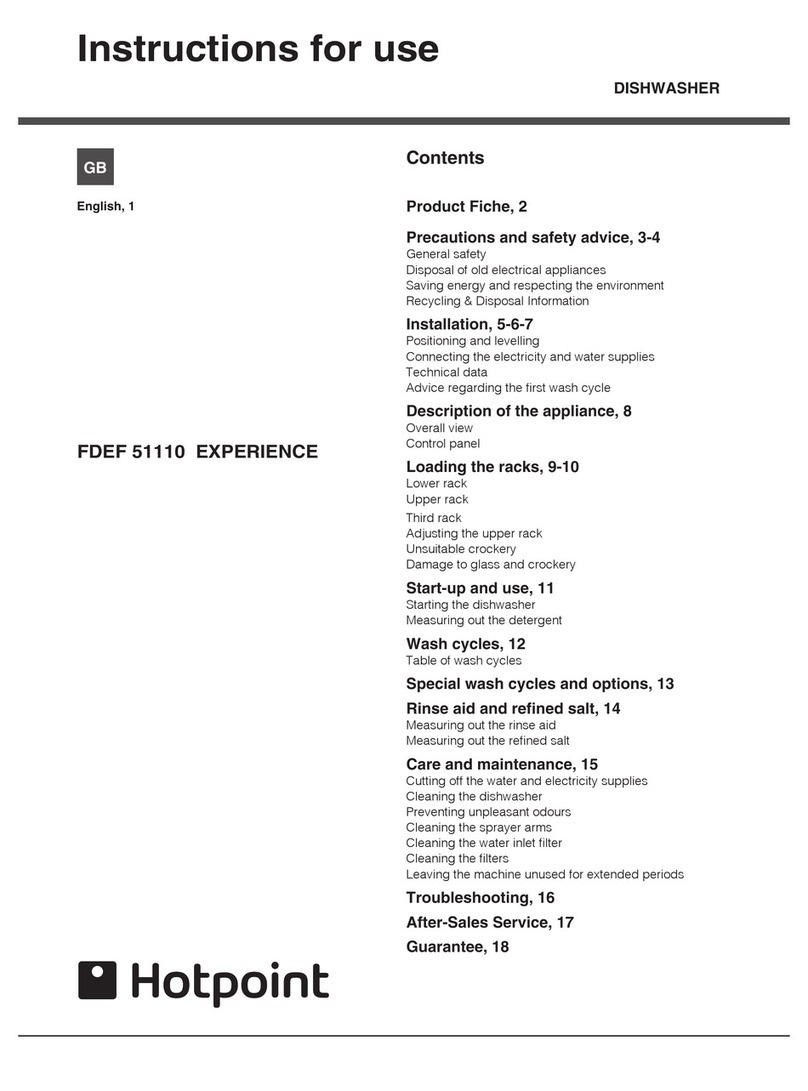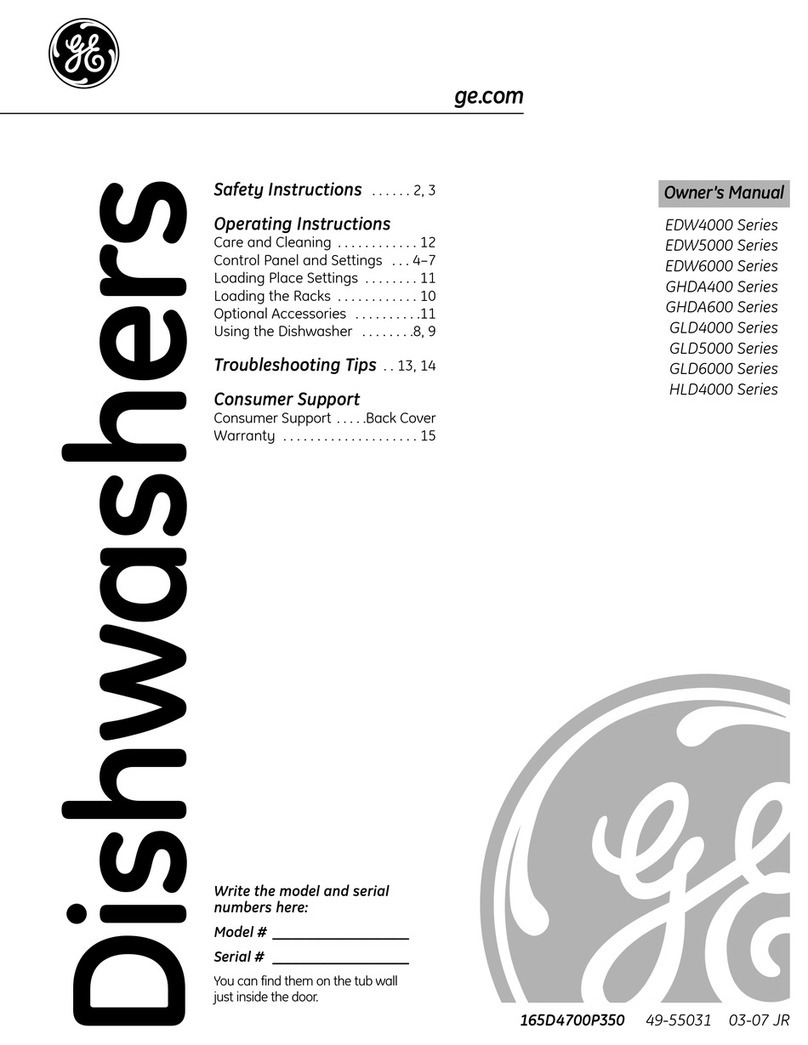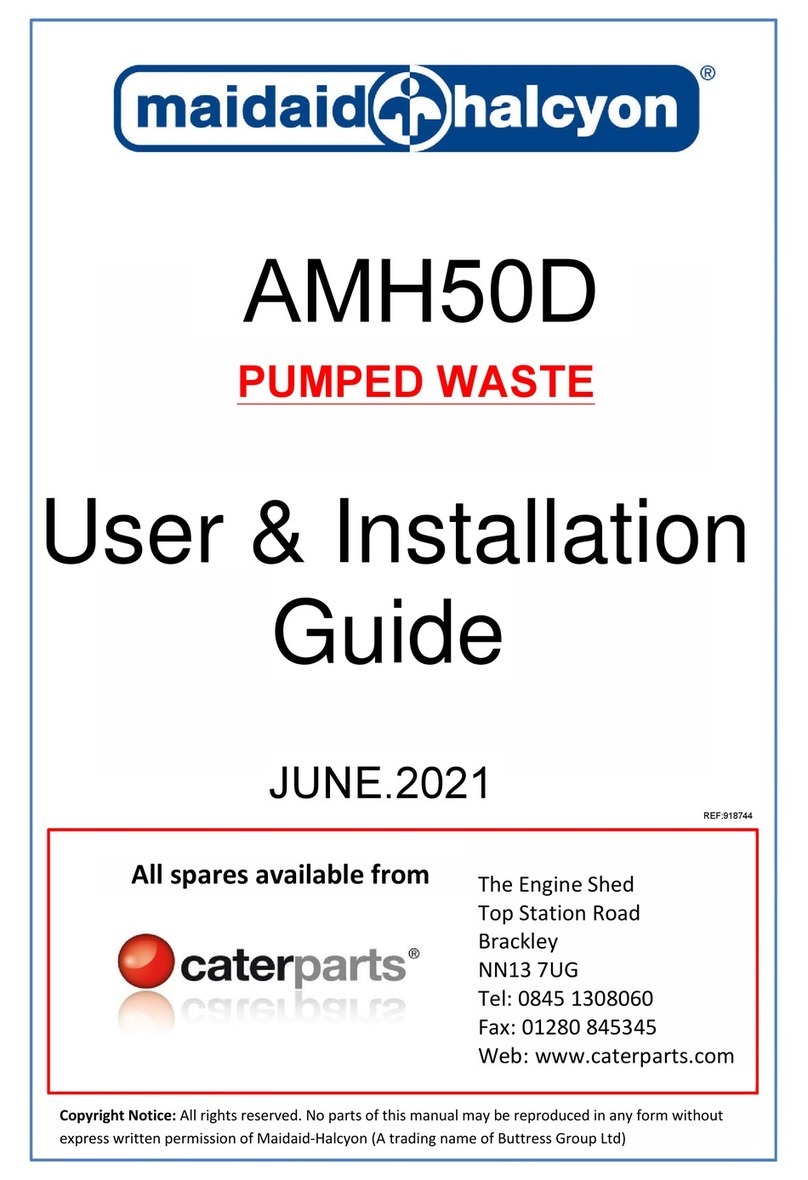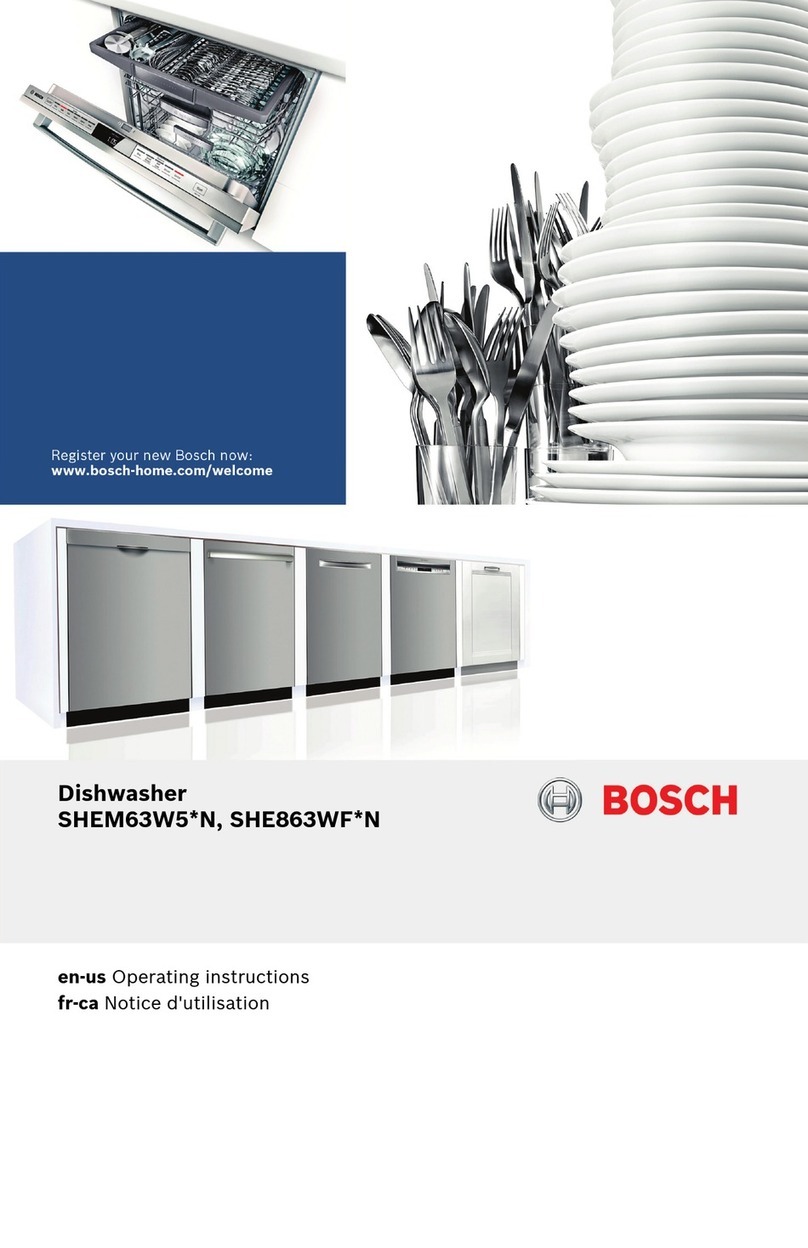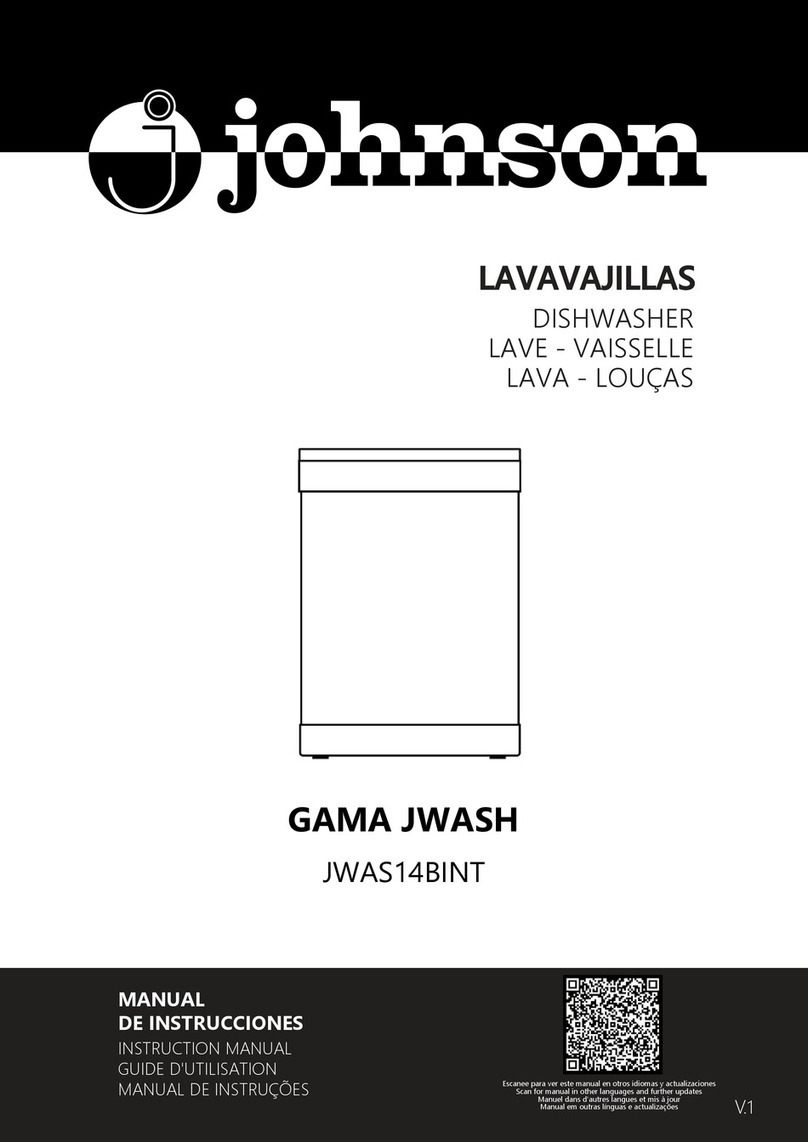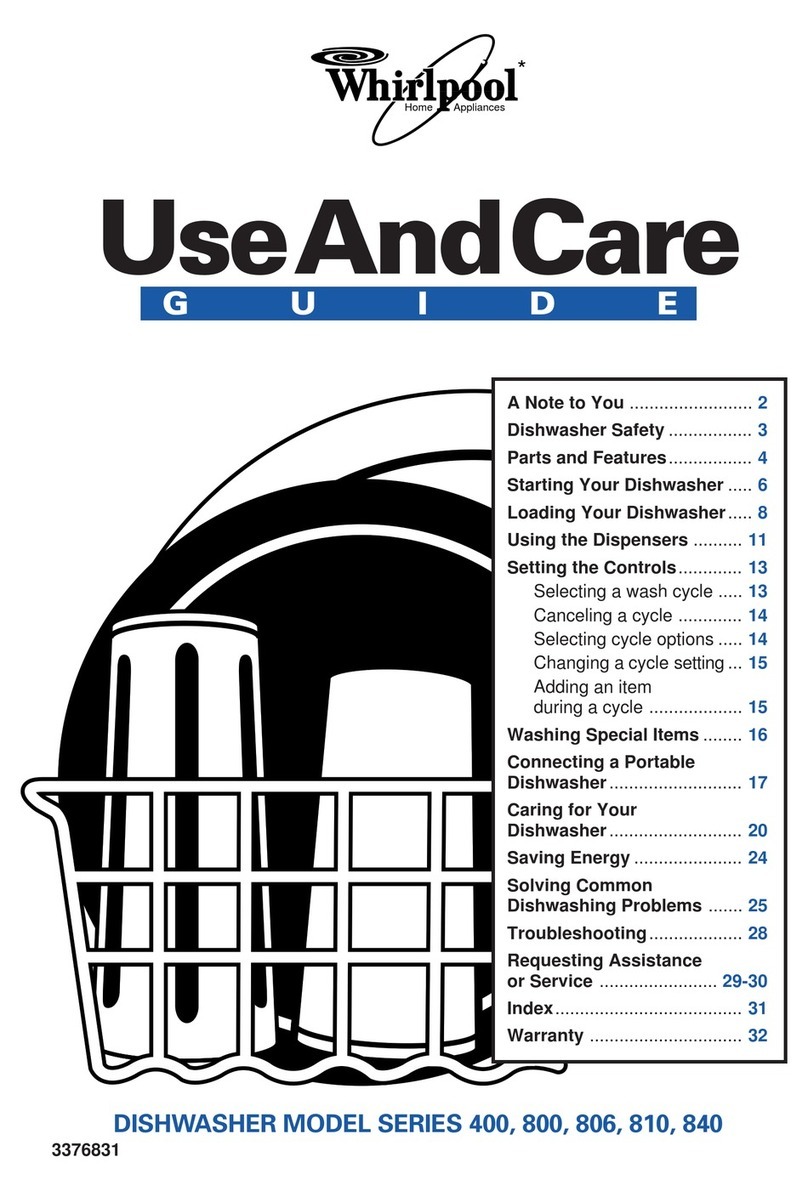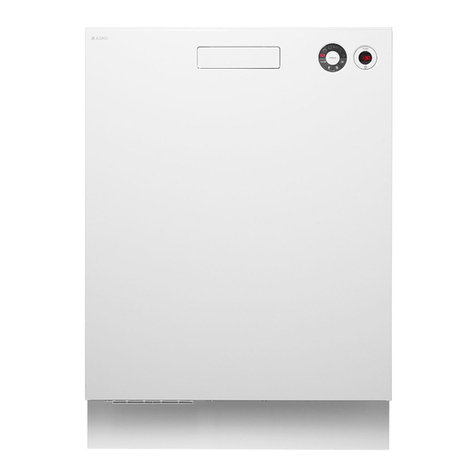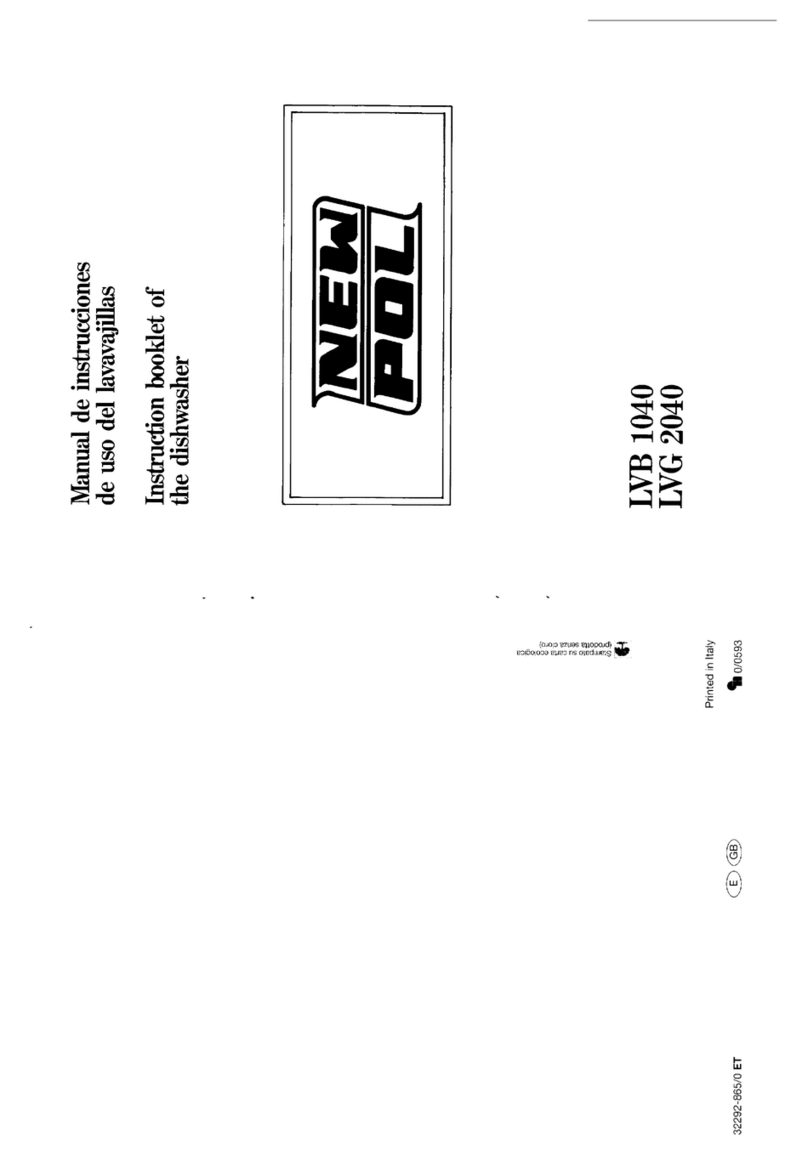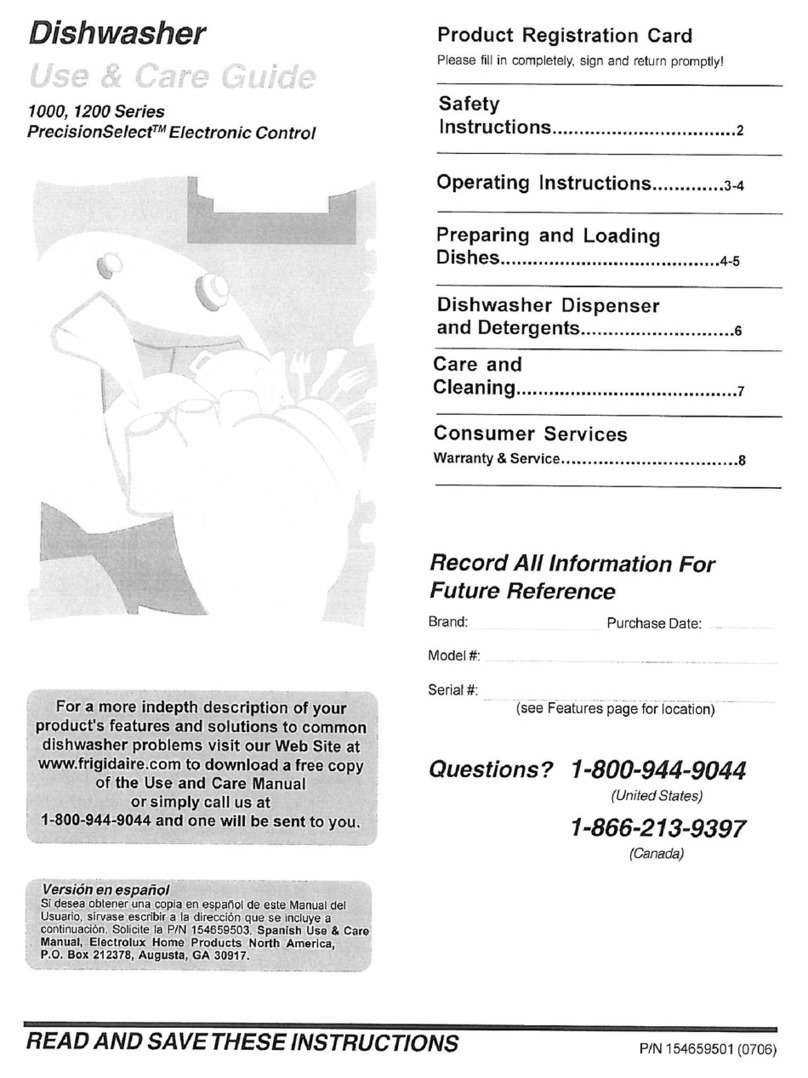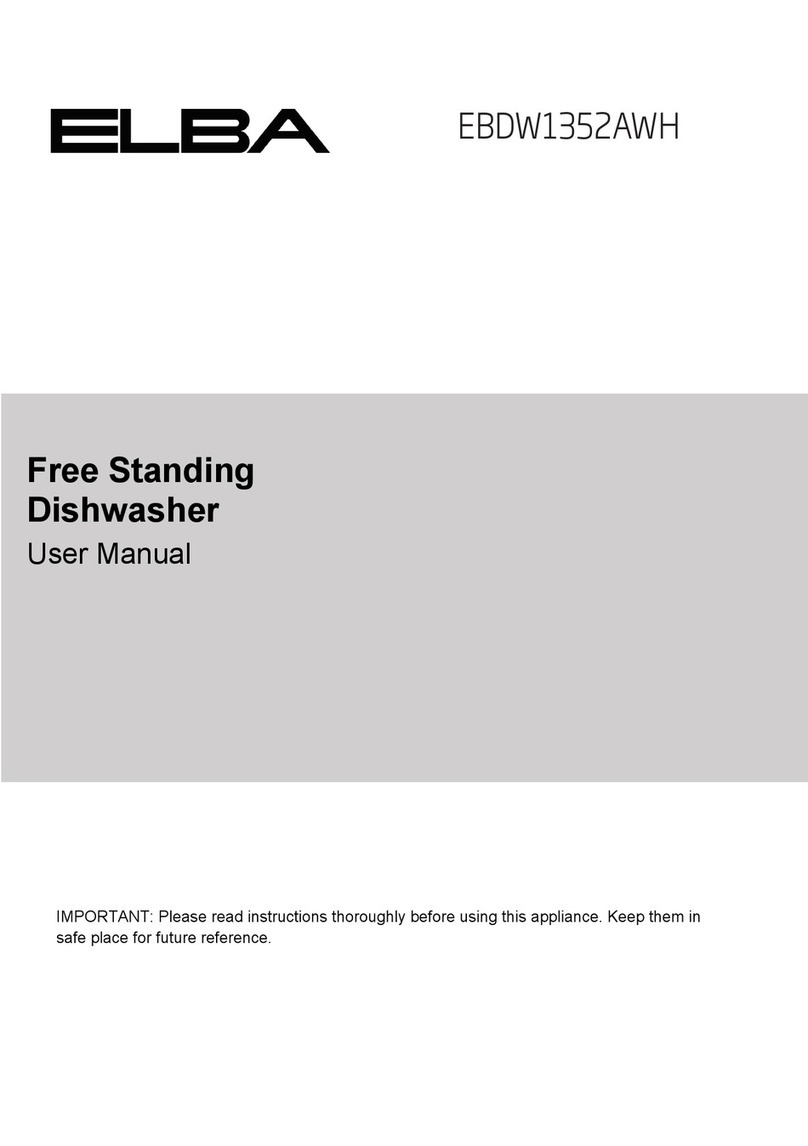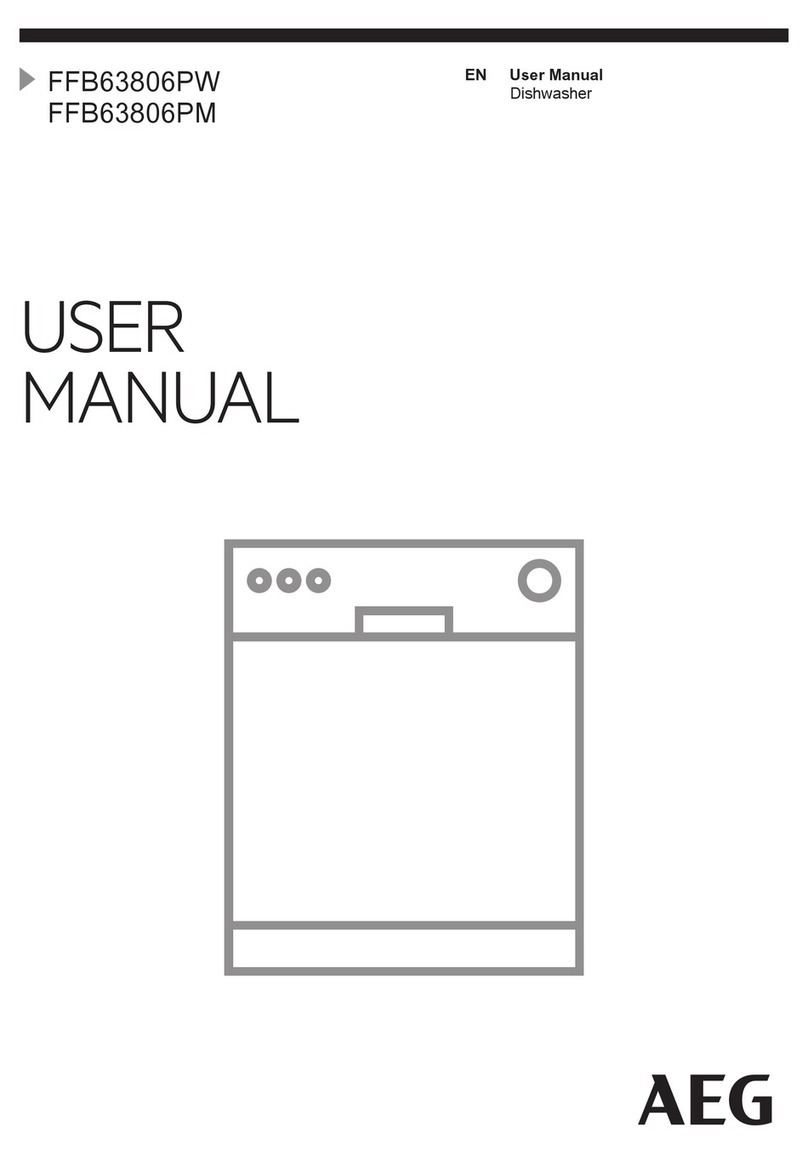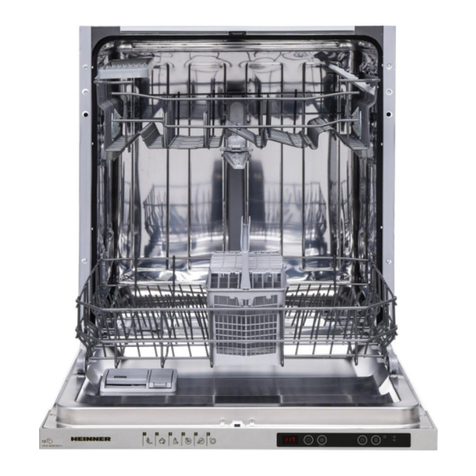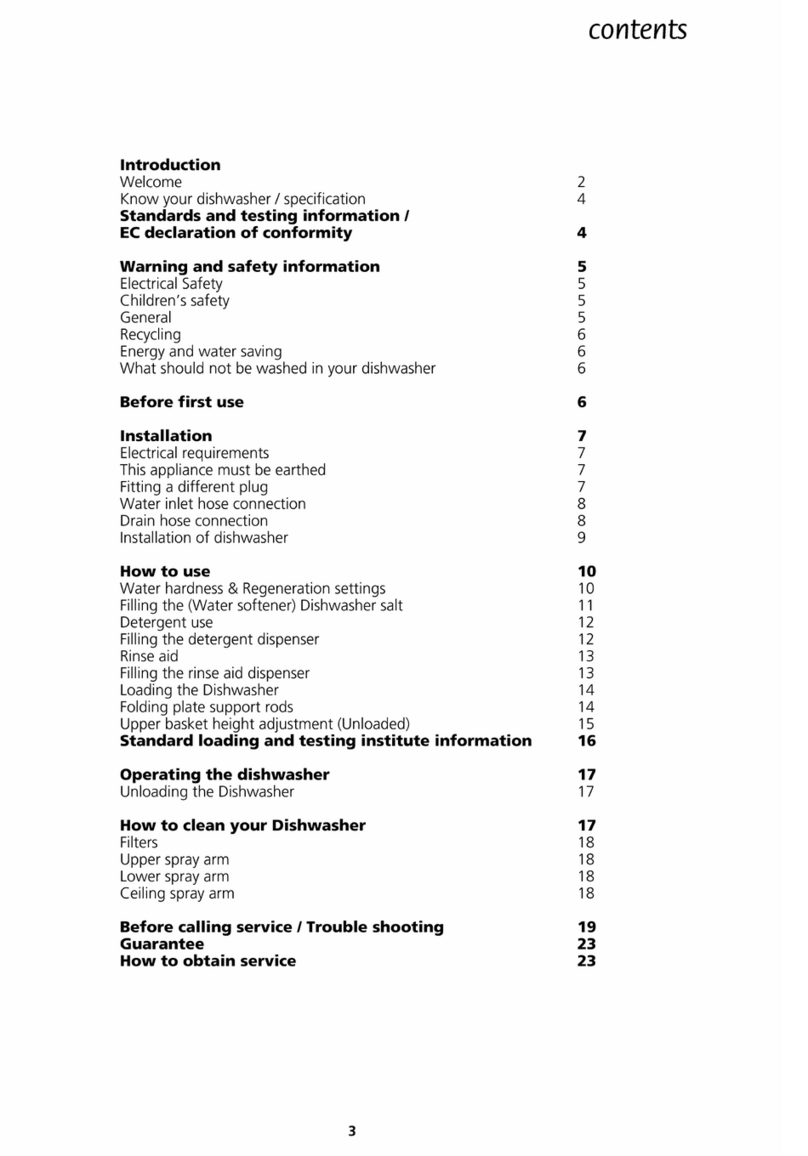Atag VA7016WTC User manual

Operating Instructions
VA7016WTC

Contents
2Your dishwasher
3Safety instructions
4Before washing for the first time
7Loading the dishwasher
10Using the dishwasher
14Settings
17Care and cleaning
19Troubleshooting
22Technical information
23Installation
24Service
25Information for test institute
26Your notes
28Quick guide
Your dishwasher
Open the door and press the main power switch.
"This is a first time set up." is shown on the display the first time the dishwasher is switched on. It is important that you choose the
right settings to ensure good dishwashing results. See page 4.
You can remote control this dishwasher with your smartphone/tablet. Connect the dishwasher to your local wireless network to
be able to remote control the dishwasher using the ATAG Connect Life app. The app can be used to find information, change
settings and monitor the dishwasher. (The dishwasher can always be used without the app.)
2:00Eco
Speed mode
START
STOP
Display Start/Stop
Programme mode selector
Navigation buttons for selecting a programme
Option Delayed Start
Option Extra Dry
Main power switch
Remote start
2

Safety instructions
•Read the operating instructions and keep
them in a safe place!
•Number of standard place settings: 14
•Never use the dishwasher for any purpose
other than that specified in these operating
instructions.
•Do not load the dishwasher door or
dishwasher baskets with anything other than
dishes.
•Never leave the dishwasher door open as
someone may trip on it.
•Use only dishwasher detergent!
•This machine can be used by children aged
8 and upwards, and by people with reduced
physical capacity, mental ability, memory
loss or lacking experience and knowledge.
These individuals must be supervised when
using the machine or have instructions on
how to use the machine and understand the
risks that can occur. Cleaning of the machine
must not be carried out by children without
supervision.
•Damaged mains cables must only be
replaced by a qualified electrician.
•Only use the dishwasher in household-type
environments for dishwashing household
dishes. All other use is prohibited.
•Never place dishes with solvent residues in
the dishwasher due to the risk of explosion.
Nor may dishes that contain ash, wax or
lubricants be washed in the dishwasher.
•Children must be watched. Do not allow
children to use or play with the dishwasher.
Be especially vigilant when the door is open.
Some detergent may remain inside! After
adding detergent, always start the
dishwasher immediately.
WARNING!
Knives and other pointed items must be placed
with the points down in the cutlery basket or
horizontally in other baskets.
WARNING!
Children must be supervised –dishwasher
detergent is corrosive!
Activate child lock (button lock)
You can activate the child lock (button lock) to prevent children from
starting the dishwasher. See the chapter Settings.
Installation
See the chapter Installation.
Winter storage/Transport
Store the dishwasher above freezing and avoid long transport distances
in very cold weather. Transport the dishwasher upright or laying on its
back.
Before transporting a used dishwasher all water must be pumped from
the machine. Run the Rinse and hold programme.
Overflow guard function
The overflow protection starts pumping out the machine and turns off
the water supply if the water level in the dishwasher exceeds the normal
level. If the overflow protection is triggered, turn off the water supply
and call the service department.
Packing material
The packaging protects the product during transport. The packaging
material is recyclable. Separate the different packaging materials to
help reduce raw material use and waste. Your dealer can take the
packaging for recycling or direct you to the nearest recycling centre.
The packaging is comprised of:
•Corrugated cardboard made from up to 100% recycled material.
•Expanded polystyrene (EPS) with no added chlorine or fluorine.
•Supports made from untreated wood.
•Protective plastic made from polyethylene (PE).
Disposal
The dishwasher is manufactured and labelled for recycling.
When the dishwasher has reached the end of its service life and is to
be disposed of, it should immediately be made unusable. Pull out the
power cable and cut it as short as possible.
Contact your local authority for information about where and how your
dishwasher should be correctly recycled.
3

Before washing for the
first time
1. Checking water hardness
In order to achieve good dishwashing results, the dishwasher needs
soft water (water with low mineral content). Hard water leaves a white
coating on dishes and the dishwasher.
Water hardness is specified using the German water hardness scale
(°dH) or the French water hardness scale (°fH).
A water supply with a water hardness in excess of 6°dH (9°fH) must
be softened. This is done automatically with the aid of the built-in water
softener. In order for the water softener to function optimally, it must
be adjusted to the hardness of the water supply. Once you have
adjusted the water softener, use detergent and rinse aid doses suitable
for soft water.
Contact the local waterworks to check the water hardness in your area.
Make a note of the water hardness:____________
Recommended
setting
French water
hardness scale
German water
hardness scale
00-9°fH0-5°dH
110-14°fH6-8°dH
215-20°fH9-11°dH
321-25°fH12-14°dH
426-34°fH15-19°dH
535-43°fH22-24°dH
644-52°fH25-29°dH
753-70°fH30-39°dH
871-88°fH40-49°dH
989°fH50°dH
If the water hardness exceeds 50°dH (89°fH), we recommend
connecting an external water softener.
WARNING!
Hard water leaves a white coating on dishes and inside the
dishwasher. It is therefore important that you select the right setting
for the water softener! See Water hardness.
Never run the dishwasher with an empty salt compartment if the water
supply has a water hardness in excess of 6°dH (9°fH).
2. ATAG Connect Life
You can remote control this dishwasher with your smartphone/tablet.
Connect the dishwasher to your local wireless network to be able to
remote control the dishwasher using the ATAG Connect Life app. The
app can be used to find information, change settings and monitor the
dishwasher. (The dishwasher can always be used without the app.)
Preparations
•Your smartphone/tablet must be connected to the internet.
•The router in your local wireless network must be connected to the
internet and the dishwasher must be in range of your local network.
•Use your smartphone/tablet to download the ATAG Connect Life
app (from App Store / Google play). Open the app and register an
account.
•Activate the dishwasher's Network and pair the dishwasher with
your smartphone/tablet. See "This is a first time set up.", which is
shown on the display the first time the dishwasher is switched on,
or the dishwasher's Settings menu.
4

3. Basic settings
Open the door and press the main power switch.
"This is a first time set up." is shown on the display. It is important
that you choose the right settings to ensure good dishwashing results.
Confirm setting
Select setting
Main power switch
Settings
Language1.
Select the language to be shown on the display.
Rinse aid 0/1/2/3/4/5/TAB3.
Drying is faster and a better result is achieved if you use rinse aid.
You will also achieve a better dishwashing result with clear and
spotless dishes.
Select rinse aid dosage. The rinse aid dispenser can be adjusted
between 0 (Off) and 5 (High dosage).
When using an all-in-one detergent that contains rinse aid, you can
activate the setting TAB. Read more about all-in-one detergent in the
chapter Using the dishwasher.
Pre-selected at factory: 5
Top up rinse aid
Press to open
1. Open the rinse aid compartment lid.
2. Carefully top up with rinse aid to the level marked max.
3. Wipe up any splashes of rinse aid around the compartment.
4. Close the lid firmly.
Water hardness 0/1/2/3/4/5/6/7/8/94.
Adjusting the water softener. Select a setting depending on the
hardness of the water supply. It is important that this setting is correct!
Do not forget to put salt in the salt compartment after you have set
the water softener to 1 - 9.
For a water supply with a hardness under 6°dH (9°fH), select 0. The
water softener is deactivated and no salt is needed.
Pre-selected at factory: 4
Top up salt
Salt compartment lid
1. Unscrew the salt compartment lid.
2. Place the funnel supplied with the dishwasher in the salt
compartment top-up hole. First, pour in about 1 l of water.
3. Then add salt, a maximum of 1.0 kg, until the compartment is full.
Use large grain salt or special dishwasher salt.
4. Wipe up any excess salt so that the lid can be screwed on firmly.
In order to avoid rust stains a dishwashing programme must be started
immediately after adding salt.
5

Network Yes/No5.
Connect the dishwasher to your local wireless network to be able to
remote control the dishwasher using the ATAG Connect Life app.
Select Yes if you want to connect the dishwasher.
Select No if you do not want to connect the dishwasher.
Connect automatically with Activate WPS (if the network router has a
WPS function) or manually with Activate softAP.
Network Activate WPS (automatic)
•Select Activate WPS to automatically connect the dishwasher
to your local network.
•Press WPS button on your router within 2 minuters. (If you
need more time, select Activate WPS again.)
or
Network Activate softAP (manual)
•If you cannot connect automatically:
Select Activate softAP to manually connect the dishwasher
to your local network. (The dishwasher's wireless network is
now visible for 5 minutes. If you need more time, select
Activate softAP again.)
•Open the settings menu on your smartphone/tablet.
Search for the dishwasher's wireless network ConnectLife.
Log in with the password ConnectLife.
NB: The password is case sensitive.
•Open the web browser on your smartphone/tablet.
Go to http://192.168.1.1.
Username: ConnectLife
Log in with the password ConnectLife.
NB: The username and password are case sensitive.
•A menu opens:
SSID: Enter the name of your local wireless network.
Security: Select the router's security level (usually WPA2).
Key: Enter the password for your local wireless network.
IP Configuration, Mode: Automatic
Select Apply. When you receive the message Settings
applied, select Confirm.
NB: If a pop-up message opens, you can close it.
The dishwasher's network symbol flashes when the
dishwasher is connected to the network.
The dishwasher's network symbol glows steadily and
"Cloud connection successful" is shown on the display
once the dishwasher is connected to the network and the
cloud. (This may take a few minutes.) Confirm with .
Pair the dishwasher with your smartphone/tablet to be able to remote
control the machine. Use your smartphone/tablet to download the
ATAG Connect Life app (from App Store / Google play). Open the app.
Register an account and log in.
In the app's My Appliances menu, select Add A New Appliance and
continue in the dishwasher's Settings menu.
Network Device pairing 1)
•Select Device pairing.
•Scan the dishwasher's QR code with your smartphone/tablet
(or enter the AUID code).
AUID:
QR code
AUID code (37 digits)
"Device successfully paired" is shown on the display when you are
done.
The dishwasher appears in the ATAG Connect Life app. You can now
remote control the dishwasher. See Remote control the dishwasher in
the chapter Using the dishwasher.
NOTE!
Once you have connected the dishwasher, you can select Turn off
network to deactivate the connection. Select Turn on network to
reconnect to the same network. See the chapter Settings.
To change the selected setting, see the chapter Settings.
1) Shown in the dishwasher's Settings menu when the dishwasher is connected to the network and the cloud.
6

Loading the dishwasher
Greener dishwashing
Do not rinse under running water
Simply scrape off large food particles before loading the dishwasher.
Choose a green detergent
Read the environmental declaration on the packaging!
Run programmes only with a full load
Wait to run a programme until the dishwasher is full, this way you save
energy. Use the Rinse and hold programme to rinse the dishes if there
are any unpleasant odours while you wait for the dishwasher to become
fully loaded.
Run programmes at a lower temperature
If the dishes are only slightly dirty, you can select a programme with
a low temperature.
Select ECO wash
This programme is intended for cleaning normally dirty dishes and is
the most effective programme in terms of combined energy and water
consumption.
The dishwashing programme is designed for an effective wash using
as little energy and water as possible. The programme washes at a
low temperature for a long time.
Select Green mode
The dishwasher has different programme modes. To save energy and
water, use Green mode. (Available with: Normal wash, Daily wash)
Open the door a little once the programme has finished
Better drying results are achieved if you open the door a little once the
programme has ended. (If the dishwasher is built-in the surrounding
furnishings must be resistant to any condensation from the dishwasher.)
Connect to cold water
Connect the dishwasher to the cold water supply if the building is
heated using oil, electricity or gas.
Connection to hot water supply
Connect the dishwasher to the hot water supply (max. 70 °C) if the
building is heated using an energy-efficient means such as district
heating, solar power or geothermal power. Choosing a hot water
connection cuts dishwashing times and reduces the dishwasher's
energy consumption.
NOTE!
Do not exceed the permitted water supply temperature. Certain
materials used in some cookware cannot withstand strong heat.
Fragile dishes
Some cookware is not dishwasher safe. This can be for several reasons.
Some materials cannot withstand strong heat, others can be damaged
by dishwashing detergent.
Exercise caution with, for example, handmade items, fragile decoration,
crystal/glassware, silver, copper, tin, aluminium, wood and plastic.
Look for the "Dishwasher safe" marking.
Fragile decoration
Porcelain with decoration on top of the glazing (the items feel rough)
should not be washed in a dishwasher.
Crystal/Glass
Wash fragile items made of crystal/glass using the gentle dishwashing
programme Crystal glass. Remember to use a small amount of
detergent and to place items so that they do not touch each other
during the wash.
Drying is faster and a better result is achieved if you use rinse aid. You
will also achieve a better dishwashing result with clear and spotless
dishes.
Hand-painted glassware, as well as antique and very fragile items,
should not be washed in a dishwasher.
Silver
Silver and stainless steel items should not come into contact, as the
silver can become discoloured.
Aluminium
Aluminium can lose its shine if washed in a dishwasher. However, good
quality aluminium pans can be washed in a dishwasher, even if some
of the shine will be lost.
Cutlery with glued handles
Some types of glue are not dishwasher safe. In such cases, the handles
may loosen.
Points to consider
•All dirty surfaces should face inwards and downwards!
•Dishes should not be placed in or on each other.
•Angle dishes with hollows, such as cups, so that the rinse water
will run off. This is also important for plastic items.
•Make sure small items cannot fall through the dishwasher basket;
place them in the top cutlery tray.
NOTE!
Check that the spray arms can rotate freely.
7

The dishwasher's baskets
The dishwasher is equipped with a top cutlery tray, an upper basket
and a lower basket with a cutlery basket.
The appearance of the baskets may differ depending on the dishwasher
setup.
Top cutlery tray
The top cutlery tray has space for cutlery, ladles, whisks, serving cutlery
and similar items.
Raising the top cutlery tray
1. Pull out the top cutlery tray.
2. Pull forward the two locking handles on either side to raise the top
cutlery tray.
Lowering the top cutlery tray
1. Make sure the upper basket is in the lowest position.
2. Pull out the top cutlery tray.
3. Slide the two locking handles on either side downwards and
backwards to lower the top cutlery tray.
Upper basket
Place glasses, cups, bowls, side plates and saucers in the upper
basket. All dirty surfaces should face inwards and downwards! Wine
glasses are placed on the wine glass shelf and knives are placed in
the knife stand on the right.
Raising the upper basket
1. Pull out the upper basket.
2. Grab the sides of the upper basket with both hands and lift it up.
Lowering the upper basket
1. Pull out the upper basket.
2. Pull out the two locking handles on either side to lower the upper
basket.
Lower basket
Place plates, side plates, serving dishes, pots and cutlery (in the cutlery
basket) in the lower basket.
Place pots and pans in the rear right part of the lower basket to best
utilise dishwashing performance from the rear of the two spray nozzles,
which are intended for these types of dishes.
Foldable tines
Lower the foldable tines (plate supports) when washing pots. Release
the foldable tines by pressing the catch inwards before adjusting their
position.
8

Washing large plates
Move foldable tines and their mounts to widen the distance between
the tine rows to adapt the lower basket to plates with a diameter greater
than 25 cm.
Cutlery basket
Place cutlery with the handles facing down, except for knives, and
spread them out as much as possible. Ensure that spoons do not stack
inside each other.
The cutlery basket is best placed in the middle at the front of the lower
basket to best utilise dishwashing performance from the unique spray
nozzle, which is intended for the cutlery basket.
WARNING!
Knives and other pointed items must be placed with the points down
in the cutlery basket or horizontally in other baskets.
Fold-down section for small items
The cutlery basket has a fold-down section in the middle for small
items, or small shafts, such as electric whisk attachments.
9

Using the dishwasher
Remote control the dishwasher
You can use your smartphone/tablet to remote control this dishwasher.
Connect the dishwasher to your local wireless network to be able to
remote control the dishwasher using the ATAG Connect Life app. The
app can be used to find information, change settings and monitor the
dishwasher. You can even start and cancel a programme.
The dishwasher's network symbol glows steadily when the
dishwasher is connected to the network and the cloud. You can
use the ATAG Connect Life app.
Remote start the dishwasher
To remote start the dishwasher, press the navigation buttons and
until Remote start active appears on the display. Close the door. In the
ATAG Connect Life app, select the desired programme and start the
dishwasher.
Remote start
NOTE!
If the door is not closed within 2 minutes, the machine switches off.
Status light
Flashing blue indicates that Remote start is activated. In the ATAG
Connect Life app, select the desired programme and start the
dishwasher.
NOTE!
The dishwasher can always be used without the app. When the
dishwasher's buttons are pressed, commands from the ATAG
Connect Life app are blocked for 10 seconds.
Add detergent
Press to open
1. Prewash detergent compartment
2. Main wash detergent compartment
Detergent is added according to water hardness.
Follow the instructions on the detergent packaging. This dishwasher
is fitted with a water softener, so use detergent and rinse aid doses
suitable for soft water.
Too much detergent can result in less effective dishwashing and also
entails greater environmental impact.
The detergent compartment must be dry when adding detergent. There
is one compartment for the prewash and one for the main wash. If
powder or liquid dishwasher detergent is used, add a small amount
of the detergent to the prewash compartment. Contact the detergent
manufacturer if you have questions about the detergent.
NOTE!
Use only dishwasher detergent! Washing up liquid must not be used
as the foam that forms prevents the dishwasher from operating
effectively.
Dishwasher tablets
Halve the tablet if it is difficult to close the dispenser lid. There is a risk
that the detergent will not be released properly if the lid is tight and
will not open correctly.
NOTE!
Dishwasher tablets are not recommended for short programmes
(less than 75 minutes). Use powder or liquid dishwasher detergent
instead.
All-in-one detergent
There are many types of all-in-one detergents on the market. Read
through the directions for these products carefully.
When using an all-in-one detergent that contains rinse aid, you can
activate the setting TAB. Note that the salt compartment must be filled
with salt.
NOTE!
Optimal washing and drying results are achieved by using normal
dishwasher detergent together with separately dispensed rinse aid
and salt.
10

Eco
Speed mode
2:00
START
STOP
Select a programme mode Select any options
Open the door and press the main power switch.
Select the programme
Starting the dishwasher
The main power switch
Open the door and press the main power switch. Also turn on the water
tap if it is turned off.
Select a programme
ECO wash is always pre-selected. To select another programme, press
the navigation button or until the desired programme is shown on
the display.
Select a programme to suit the type of dishes and how dirty they are.
ECO wash
This programme is intended for cleaning normally dirty dishes and is
the most effective programme in terms of combined energy and water
consumption.
You can read more about greener dishwashing in the chapter Loading
the dishwasher.
Normal wash
Powerful programme for daily use that can remove dried leftovers, but
is not intended for burnt food, such as on oven dishes. This programme
provides maximum rinse effect, and takes longer than Daily wash.
Auto wash
The dishwasher can measure how dirty the dishes are and adjust water
consumption and temperature accordingly. When newly installed, the
programme needs to be run five times before it is fully adapted and
can provide the best results.
Daily wash
An effective programme for daily use for slightly dried leftovers. (This
programme is not intended for burnt food, such as on oven dishes.)
Time program
The programme adapts to the specified running time or finish time.
With this programme it is important to choose a time suited to how dirty
the dishes are.
Slightly dirty dishes0:15-0:45
Normally dirty dishes1:00-1:30
Very dirty dishes2:00-2:30
Press the option button to set the desired programme time.
Rinse and hold
Used to rinse dishes while you wait for the dishwasher to become fully
loaded.
Plastic wash
A programme intended for washing plastic items that are dishwasher
safe. This programme has an extra long drying cycle. Porcelain and
glasses can also be washed.
Hygiene wash
This programme is ideal to use where demands on hygiene are extra
high, e.g. for baby bottles and cutting boards. The temperature is high
both in the main wash and in the final rinse.
Crystal glass
A gentle dishwashing programme with a low temperature for washing
fragile items made of crystal/glass. Remember to use a small amount
of detergent and to place items so that they do not touch each other
during the wash. See also Fragile dishes in the chapter Loading the
dishwasher. Porcelain that has just been used without dried leftovers
can also be washed using this programme.
Quick Pro wash
Shorten the dishwashing programme by preheating the water. This
programme is not intended for dried leftovers. Remember to scrape
off larger food particles before loading the dishwasher.
Step 1: To prepare the programme, press Start/Stop until the display
shows "Preheating". Close the door. (The spray arms rotate while the
water is being preheated.) Wait until the status light turns green and
the display shows "Preheating ready", which indicates that the
dishwasher is ready to start (within 180 minutes).
You can load the dishes while the water is being preheated.
Step 2: To start the programme, press Start/Stop until the display shows
"Program started, close door". Close the door properly, otherwise the
dishwasher will not start.
Self-cleaning
Self-cleaning programme for hygienic cleaning of the dishwasher tub,
spray arms and spray pipes.
This programme should be run (with no dishes in the machine) using
normal dishwasher detergent or citric acid. Special dishwasher cleaners
are also available on the market. For the removal of limescale deposits,
see The dishwasher tub in the chapter Care and cleaning.
Upper half wash
You can use this programme if you only have cups and glasses that
need washing in the upper basket. Slightly dirty dishes can also be
placed in the lower basket.
Lower half wash
You can use this programme when you only want to wash plates and
cutlery in the lower basket. Slightly dirty dishes can also be placed in
the upper basket.
Select a programme mode
To select a programme mode, press the programme mode selector
until the desired mode is shown on the display. The available
programme modes vary between programmes.
Green mode
The dishwasher uses less energy and water. The programme time is
extended.
11

Speed mode
The programme time is shortened, but the dishwasher uses more
energy.
Night mode
Lower noise level during the dishwashing programme. The programme
time is extended.
Intensive mode
Improves the dishwashing results, but the dishwasher uses more energy
and water. The programme time is extended.
Select an option
To select an option, press the option button until the desired option is
shown on the display. The available options vary between programmes.
Extra Dry
A higher temperature in the final rinse and a longer drying cycle
improve the drying results if you activate this option. Energy
consumption is slightly increased.
Delayed Start
When you select Delayed Start, the dishwasher will start 1-24 hours
after you have pressed the button Start/Stop and closed the door.
1. Press the button once to activate Delayed Start. Press the button
several times –or hold it in –to set the desired number of hours.
2. Press Start/Stop and close the door. The timer counts down and
the dishwasher starts after the selected delay.
If you want to cancel the Delayed Start option, open the door then
press and hold Start/Stop for three seconds.
START
STOP
Starting the dishwasher
Press Start/Stop until the display shows "Program started, close door".
This indicates that the dishwasher is ready to start. Close the door
properly, otherwise the dishwasher will not start.
If the dishwasher is not started or the door is not closed within 2 minutes
of the last button press, the machine switches off.
Time remaining
Once you have chosen a programme, programme mode and options,
the time the programme took when last used is displayed.
Status light
Status light
The status light at the bottom on the dishwasher provides information
by means of 3 different colours.
Blue - Load more
The programme has started, but you can still load more dishes.
Flashing blue indicates that Remote start is activated. In the ATAG
Connect Life app, select the desired programme and start the
dishwasher.
Red - Do not load
You should not load more dishes (risk of poorer dishwashing result).
Flashing red indicates a problem. See also the chapter Troubleshooting.
Green - Unload
The dishwashing programme is finished. Standby light for 60 minutes.
Stopping or changing a programme
If you want to change programme after starting the dishwasher, open
the door then press and hold Start/Stop for three seconds. Add more
detergent if the lid of the detergent dispenser has opened. Then choose
a new programme, press Start/Stop and close the door.
If you want to load more dishes
Open the door. The dishwasher stops automatically. Add the dishes
and close the door. After a while, the dishwasher continues the
programme.
If the dishwashing programme was started using Remote start, the
interrupted programme (without the function Remote start) continues
when the door is closed.
If the dishwasher is turned off due to a
power failure
If the dishwashing programme was not finished, the interrupted
programme continues when power is restored.
If the dishwashing programme was started using Remote start and
was not finished, the interrupted programme (without the function
Remote start) continues when power is restored.
NOTE!
During drying, the programme is interrupted if the power is cut or
the door is open for more than 2 minutes.
Once the programme has finished
The end of the programme is indicated by one short signal from the
buzzer. The chapter Settings describes how to change this function.
Moreover, the end of the programme is indicated by the status light
turning green.
The dishwasher switches off automatically after the programme ends.
Shut off the water tap after each use.
How to get the best drying results
•Fully load the dishwasher.
•Angle dishes with hollows, such as cups, so that the rinse water
will run off. This is also important for plastic items.
•Top up with rinse aid or increase the rinse aid dosage level.
•Activate the Extra Dry option.
•Activate the High temperature setting. See the chapter Settings.
•Open the door a little once the programme has finished.
•Allow the dishes to cool before unloading the dishwasher.
Unloading the dishwasher
Hot porcelain is more fragile. Leave the dishes to cool in the dishwasher
before unloading them.
Unload the lower basket first to avoid any water drops from the upper
basket falling onto the dishes in the lower basket.
12

Programme chart
Consumption values 1)
Final rinseNumber
of rinses
Main washPrewashesProgramme
mode / Option
Detergent,
compartment 2
(ml)
Programme
Water cons.
(liter)
Hot water 3)
Cold water 2)
Energy
(approx. kWh)
Dishwashing
time
(approx.
hrs:min)
Energy
(approx. kWh)
Dishwashing
time
(approx.
hrs:min)
9.50.55:300.835:5045 °C352 °C125
ECO wash 4)
130.62:051.22:2565 °C260 °C225Normal wash
11-200.5-1.01:50-2:300.9-1.52:10-2:5065 °C2-350-65 °C1-325Auto wash
150.61:351.21:5565 °C260 °C225Daily wash
11-190.4-1.20:15-2:300.5-1.60:15-2:30<65 °C2-3<65 °C0-225Time program
30.010:070.010:07--- °C1Rinse and hold
120.62:101.12:3063 °C250 °C125Plastic wash
100.91:001.41:1070 °C270 °C25Hygiene wash
90.51:200.81:4050 °C245 °C20Crystal glass
100.60:20 + 0:200.90:30 + 0:2055 °C260 °C20Quick Pro wash
120.61:501.02:1060 °C260 °C120Upper half wash
120.61:501.02:1060 °C260 °C120Lower half wash
1) Consumption values vary depending on the temperature of the incoming water, room temperature, load size, selected additional functions and more.
2) Connection to cold water, approx. 15 °C.
3) Connection to hot water, approx. 60 °C.
4) This dishwashing programme is the standard cleaning cycle used to compile the energy labelling information. It is intended for washing normally dirty dishes and is the most effective programme in terms of combined
energy and water consumption.
13

Settings
Open the dishwasher's Settings menu
To open the dishwasher's Settings menu, press the Navigation button or until Settings menu is shown on the display and confirm your selection
with the mode selector .
To exit the dishwasher's Settings menu, select Exit and confirm your selection with the mode selector .
START
STOP
1� Language English
Mode selector to confirm current setting
Settings Current setting
Navigation buttons for choosing setting
OptionsSettings
You can choose the language used for the display.English/Svenska/Dansk/Norsk/Suomi/
Nederlands/Français/Deutsch/Italiano/
Русский
/Español/Português/Sloven./
Eesti/Latviešu/Lietuvi
ų
/Hrvatski/Polish/
简体中文 / 繁體中文 / 日本語
Language1.
You can activate the child lock (button lock) to prevent children
from starting the dishwasher.
On/OffChild lock2.
To temporarily deactivate and activate the child lock, press
and hold the left Navigation button and the option button Delayed
Start for 3 seconds.
For adjusting the contrast of the display.Contrast top display1/2/3/4Display settings3.
This sound is used to confirm each button press.0/1/2/3Feedback sound4.
The buzzer indicates when a dishwashing programme has ended.0/1/2/3Buzzer volume5.
Error messages are always indicated by a loud buzzer.
Setting for rinse aid dosage. The rinse aid dispenser can be
adjusted between 0 (Off) and 5 (High dosage).
0/1/2/3/4/5/TABRinse aid6.
Increase the rinse aid dosage:
•If the dishes have water marks.
Decrease the rinse aid dosage:
•If the dishes have a sticky white/blue film.
•If the dishes are streaked.
•Build-up of foam. If you have very soft water, the rinse aid can
be diluted 50:50 with water.
When using an all-in-one detergent that contains rinse aid, you can
activate the setting TAB.
Super rinse adds two extra rinses.On/OffSuper rinse7.
Activated in the following programmes:
Normal wash
ECO wash
Daily wash
Plastic wash
Lower half wash
Upper half wash
14

OptionsSettings
Activate the setting High temperature to improve the dishwashing
results. Energy consumption is slightly increased.
On/OffHigh temperature8.
Activated in the following programmes:
Normal wash
ECO wash
Daily wash
Plastic wash
Quick Pro wash
Lower half wash
Upper half wash
On/OffNetwork9.
Connect the dishwasher to your local wireless network to be able to remote control the dishwasher using
the ATAG Connect Life app.
Turn off network/Turn on network
Once you have connected the dishwasher, you can select Turn off network to deactivate the connection.
Select Turn on network to reconnect to the same network.
Activate WPS (automatic)Network Activate WPS •Select Activate WPS to automatically connect the dishwasher
to your local network.
Connect automatically with Activate
WPS (if the network router has a WPS
function) or manually with Activate
softAP.
•Press WPS button on your router within 2 minuters. (If you need
more time, select Activate WPS again.)
Activate softAP (manual)Network Activate softAP •If you cannot connect automatically:
•Select Activate softAP to manually connect the dishwasher to
your local network. (The dishwasher's wireless network is now
visible for 5 minutes. If you need more time, select Activate
softAP again.)
•Open the settings menu on your smartphone/tablet.
Search for the dishwasher's wireless network ConnectLife.
Log in with the password ConnectLife.
NB: The password is case sensitive.
•Open the web browser on your smartphone/tablet.
Go to http://192.168.1.1.
Username: ConnectLife
Log in with the password ConnectLife.
NB: The username and password are case sensitive.
•A menu opens:
SSID: Enter the name of your local wireless network.
Security: Select the router's security level (usually WPA2).
Key: Enter the password for your local wireless network.
IP Configuration, Mode: Automatic
Select Apply. When you receive the message Settings applied,
select Confirm.
NB: If a pop-up message opens, you can close it.
The dishwasher's network symbol flashes when the dishwasher is connected to the network.
The dishwasher's network symbol glows steadily and "Cloud connection successful" is shown on the
display once the dishwasher is connected to the network and the cloud. (This may take a few minutes.)
Confirm with .
15

OptionsSettings
Pair the dishwasher with your smartphone/tablet to be able to remote control the machine. Use your
smartphone/tablet to download the ATAG Connect Life app (from App Store / Google play). Open the app.
Register an account and log in.
Network Device pairing 2)
In the app's My Appliances menu, select Add A New Appliance and continue in the dishwasher's Settings
menu.
Device pairing •Select Device pairing.
•Scan the dishwasher's QR code with your smartphone/tablet
(or enter the AUID code).
AUID:
QR code
AUID code (37 digits)
•"Device successfully paired" is shown on the display when you
are done.
The dishwasher appears in the ATAG Connect Life app. You can now remote control the dishwasher. See
Remote control the dishwasher in the chapter Using the dishwasher.
Built-in water tank.On/OffWater save10.
Before deactivating the water tank, run a self-cleaning programme.
See Self-cleaning in the chapter Using the dishwasher.
Adjusting the water softener. Select a setting depending on the
hardness of the water supply. It is important that this setting is
correct!
0/1/2/3/4/5/6/7/8/9Water hardness11.
Recommended
setting
French water
hardness scale
German water
hardness scale
00-9°fH0-5°dH
110-14°fH6-8°dH
215-20°fH9-11°dH
321-25°fH12-14°dH
426-34°fH15-19°dH
535-43°fH22-24°dH
644-52°fH25-29°dH
753-70°fH30-39°dH
871-88°fH40-49°dH
989°fH50°dH
Do not forget to put salt in the salt compartment after you have set
the water softener to 1 - 9.
For a water supply with a hardness under 6°dH (9°fH), select 0.
The water softener is deactivated and no salt is needed.
Select whether the interior light is to be switched on when the
dishwasher is turned off and the door is opened. (If the main power
switch is turned on, the interior light is always switched on when
the door is opened.)
On/OffInterior light at power off12.
To exit the dishwasher's Settings menu, select Exit and confirm
your selection with the mode selector .
Exit
2) Shown in the dishwasher's Settings menu when the dishwasher is connected to the network and the cloud.
16

Care and cleaning
Top up rinse aid
When the rinse aid needs topping up, the above symbol lights on the
display.
Press to open
1. Open the rinse aid compartment lid.
2. Carefully top up with rinse aid to the level marked max.
3. Wipe up any splashes of rinse aid around the compartment.
4. Close the lid firmly.
After topping up, it may take a while before the symbol goes out.
Top up salt
When the salt needs topping up, the above symbol lights on the display.
Salt compartment lid
When the salt runs out, unscrew the cap and fill the container with salt.
Water is only needed the first time! Wipe clean and tighten. Run a
programme to ensure that any salt in the dishwasher is rinsed away.
After topping up, it may take a while before the symbol goes out.
WARNING!
In order to avoid rust stains a dishwashing programme must be
started immediately after adding salt.
Never pour dishwasher detergent into the salt compartment. This
destroys the water softener!
Coarse filter
The coarse filter traps larger food particles, which cannot get past the
drainage pump. Empty the coarse filter when necessary.
Coarse filter
1. Lift the coarse filter by the handle.
2. Empty the coarse filter. Remember to refit it!
Fine filter
Debris that collects on the fine filter is automatically rinsed away during
each wash. Clean the fine filter when necessary.
Fine filter
1. Turn the handle anticlockwise.
2. Lift the filter straight up using the handle. Free the coarse filter to
clean the fine filter.
3. Refit in reverse order. Check that the edges seal properly when
refitting the fine filter.
4. Lock the filter in place by turning the handle clockwise to the stop
position. The handle should point straight out from the dishwasher.
NOTE!
Dishwashing results may be
affected if the filters are incorrectly
fitted. Note that the dishwasher
must not be used without the filters
in place!
NOTE!
Check that the coloured stop on
the right in the bottom drain is in
place.
Spray arms
Holes and bearings can sometimes become blocked. Remove any
debris using a pin or the like. The spray arms also have holes
underneath.
To facilitate cleaning you can remove the spray arms. Remember to
fit them firmly back into place afterwards.
Top spray arm
•The upper basket must be removed before the top spray arm can
be released. Pull out the upper basket and turn the basket catch
on each runner outwards (see illustration). The basket can now be
removed.
17

•Pull out the top cutlery tray. Press the top spray arm up and unscrew
the spray arm bearings counterclockwise to remove the spray arm.
Upper spray arm
1. Pull out the upper basket.
2. Unscrew the spray arm bearings counterclockwise to remove the
spray arm from the upper basket.
Lower spray arm
•Pull the lower spray arm straight up to release it.
The door and the door seal
Regularly clean the sides of the door and the door seal. Use a slightly
damp cloth (with a little cleaner if necessary).
Front panel
Keep the buttons clean and free from grease. Wipe them clean with a
dry or slightly damp cloth. Never use cleaners –they can scratch the
surface. Use the main power switch to turn off the dishwasher before
cleaning the buttons to avoid activating any buttons unintentionally.
The dishwasher tub
The dishwasher tub is made of stainless steel and is kept clean through
normal use.
Limescale deposits
If you have hard water, limescale deposits may build up in the
dishwasher. If this happens, run the Self-cleaning programme with two
tablespoons of citric acid in the detergent compartment (with no dishes
in the machine). Special dishwasher cleaners are also available on the
market.
Unblocking the drainage pump
If the dishwasher still contains water after the programme has finished,
something may be blocking the drainage pump. Such items are easily
removed.
1. Turn off the machine using the main power switch and unplug it
from the wall socket.
2. Remove the coarse filter and the fine filter.
3. Scoop out the water from the dishwasher tub.
4. In order to inspect the drainage pump, remove the coloured stop
on the right in the bottom drain.
5. Turn the pump wheel located behind the drainage pump stop by
hand. Carefully remove any items.
6. Refit the drainage pump stop along with the fine and coarse filters.
7. Plug the machine in again.
If the dishwasher still does not start and a whirring sound is heard,
the overflow protection has been activated.
•Shut off the water.
•Remove the plug from the wall socket.
•Call the service department.
Drainage pump stop
NOTE!
Do not forget to refit the drainage pump stop.
Unblocking the inlet hose filter
If the water supply contains small particles, the outer filter on the inlet
hose may become blocked, which results in Water inlet fault.
1. Turn off the machine using the main power switch and unplug it
from the wall socket.
2. Turn off the water tap.
3. Unscrew the inlet hose.
4. Carefully remove the outer filter from the inlet hose and clean it.
5. Refit the filter and check that the gasket is correctly positioned.
6. Screw the inlet hose firmly into place.
7. Plug the machine into the wall socket and turn on the water tap.
Allow the pressure to settle for a while and check that the connection
is watertight.
Outer filter on inlet
hose
Gasket
18

Troubleshooting
ActionType of fault on the display
Clear the drainage pump. See the chapter Care and cleaning. If the problem persists, call the
service department.
Overfilling water 1F10
See “Water remains in the dishwasher”in the table “Problem”below. If the problem persists, call
the service department.
Water outlet faultF11
Check that the water tap is on. Check that the outer filter on the inlet hose is not blocked. See
Unblocking the inlet hose filter in the chapter Care and cleaning. If the problem persists, call the
service department.
Water inlet faultF12
Turn off the water tap and call the service department.Inlet valve leakageF40
Clean the coarse and fine filters. Check that the outer filter on the inlet hose is not blocked. If the
problem persists, call the service department.
Water level faultF52
Turn off the water tap and call the service department.Overfilling water 2F54
Call the service department.Circ. pump faultF56
Press any button to clear the error message.
ActionPossible causesProblem
Wait a moment then try again.You have pressed the buttons too soon after
opening the door.
The buttons do not react when pressed.
See the chapter Settings.Child lock (button lock) activated.
Open the door. The buttons only react to use
when the door is open.
The door is closed.
Clean with a dry or slightly damp cloth.The buttons are dirty.
Check that the baskets are correctly positioned
horizontally.
The baskets are not correctly positioned.Cannot close door.
Check that the dishes are not blocking the
baskets from sliding properly into place.
Press and hold Start/Stop until the display shows
"Program started, close door".
The Start/Stop start button has been pressed for
too short a time.
The dishwasher does not start.
Check.The door is not properly closed.
Close the door and wait. After a while, the
dishwasher continues the programme.
You have opened the dishwasher to add more
dishes while a programme is in progress.
Check.A fuse/circuit breaker has been tripped.
Check.The plug is not plugged into the wall socket.
Check.The water tap is turned off.
Check.Overflow/leaks.
Turn off the water tap. Pull out the plug and call
the service department.
A whirring sound (the drainage pump) is heard
from the dishwasher and does not stop when the
main power switch is turned off.
Press and hold Start/Stop for three seconds if
you want to cancel the Delayed Start option.
Check that the Delayed Start option has not been
selected.
19

ActionPossible causesProblem
Check that the dishes are not blocking the spray
arms.
The spray arms do not rotate.The dishes are not clean.
Clean the spray arms. See the chapter Care and
cleaning.
Spray arm holes or bearings blocked.
Choose a longer programme.Unsuitable dishwashing programme.
Dose according to water hardness. Far too much
or far too little detergent results in poorer
dishwashing results.
Incorrect detergent dosage.
Avoid large packages.Old detergent. Detergent is a perishable product.
Do not cover porcelain with large bowls or the
like. Avoid placing very tall glasses in the corners
of the baskets.
Dishes loaded incorrectly.
Place dishes to sit steady.Glasses and cups have toppled over during the
programme.
Check that the filter handle is locked in the stop
position. The handle should point straight out
from the dishwasher.
The filters are not fitted correctly.
Check that the coloured stop on the right in the
bottom drain is in place. See the chapter Care
and cleaning.
Drainage pump stop missing.
Rinse off these types of foodstuffs if not starting
the dishwasher immediately. Use the Rinse and
hold programme.
Some foodstuffs, such as mustard, mayonnaise,
lemon, vinegar, salt and dressings, can mark
stainless steel if left for too long.
Spots on stainless steel or silver.
In order to avoid marks and tarnishing, separate
dishes made from different metals, such as silver,
stainless steel and aluminium.
All stainless steel can cause spots on silver if
they come into contact during dishwashing.
Aluminium can also cause spots on dishes.
See the chapter Settings.Incorrect rinse aid dosage setting.Spots or films on the dishes.
Switch all-in-one detergents or deactivate the
setting TAB and top up with salt and separate
rinse aid. See Rinse aid in the chapter Settings.
The setting TAB is activated and all-in-one
detergent with insufficient drying effect is being
used.
Top up with salt. See the chapter Care and
cleaning.
Salt compartment empty.
See Water hardness in the chapter Settings.Incorrect water softener setting.
Check that the salt compartment lid is properly
tightened. Otherwise call the service department.
The water softener is leaking salt.
Wash crystal at a low temperature and with a
conservative amount of detergent. Contact the
detergent manufacturer.
Too high temperature and/or too much detergent
can cause etching on crystal. Unfortunately, this
cannot be repaired, only prevented.
Reduce the dosage. See the chapter Settings.
If you have very soft water, you may want to dilute
the rinse aid 50:50 with water.
Rinse aid dosage setting too high.The dishes have a sticky white/blue film.
Use a detergent with a bleaching agent.Lipstick and tea can be difficult to wash off.Spots left after washing.
The detergent compartment must be dry when
adding detergent.
The detergent compartment was damp when
adding detergent.
Detergent residue in the detergent compartment
after dishwashing.
Check that the dishes are not preventing the
detergent compartment from opening.
The detergent compartment has been blocked.
Check that the dishes are placed securely. Spin
the spray arms to make sure they can rotate.
The dishes are not correctly placed or the spray
arms are not rotating.
Rattling sound when dishwashing.
Run a self-cleaning programme. See
Self-cleaning in the chapter Using the
dishwasher.
The dishwasher tub, spray arms and spray pipes
need to be cleaned.
"Run Self-cleaning program" is shown on the
display.
Connect the dishwasher to the local network.
See Network in the chapter Settings.
The dishwasher has not been connected to the
local network.
"Connection failed" is shown on the display when
navigation buttons and are pressed.
20
Table of contents
Other Atag Dishwasher manuals

